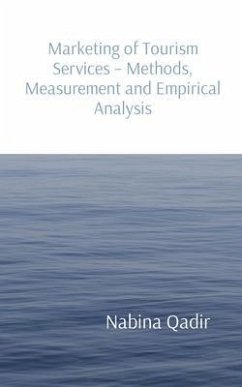The increased significance of the services sector to the global economy has led to an increased concern by practitioners as well as consumers regarding the quality of services being offered. In a highly competitive tourism industry, delivering high quality service and ensuring tourist satisfaction are widely recognized as important factors for gaining competitive advantage in the market place. High quality tourism service attracts large number of tourists and ensures tourist retention. Tourist retention provides higher profit contribution in terms of favourable behavioural intentions/repeat visits and positive word of mouth communication. Besides, the need for delivering quality tourism services arise due to the fact that foreign exchange earnings in this industry has a high added value which contributes to the growth of the GDP of an economy. Providing high quality tourism services depends on the destination's ability to exceed the expectations of the visitors. Therefore, it becomes essential to study the quality of services, the destination is offering to tourists.
The objectives of the present study were: (a) to measure the quality of tourism services in Kashmir; (b) to study the quality of tourism services across demographic variables; (c) to study the gap between tourists' expectations and their perceptions; (d) to study the gap in tourism service quality as perceived by domestic and foreign tourists; and, (e) to study the relationship between tourism service quality, satisfaction and behavioural intentions of tourists. Data has been collected through both primary as well as secondary sources. All the three constructs were measured with the help of a self- administered questionnaire. For measuring the service quality construct, the 22 items SERVQUAL scale developed by Parasuraman, et. al., (1985) was modified and extended up-to 32 items to suit the present research purposes. However, for measuring satisfaction and behavioural intentions constructs, the elements have been adapted from Westbrook and Oliver (1991) and Baker and Crompton (2000). All the three scales were measured on a ten-point Likert type (strongly disagree/strongly agree) scale. Using simple random sampling technique, a total of one thousand forty-three (1043) filled in questionnaires were used for the purpose of analysis. In order to determine the dimensions of tourism service quality, factor analysis on 32 items was performed that revealed five (5) factors with twenty-nine (29) items and 67.94% Explained Variance. Cronbach's Alpha test was carried out to test the reliability of each dimension/construct.
The findings of the study indicate higher levels of tourism service quality (0.43), higher levels of tourist satisfaction (7.37) and favourable behavioural intentions (7.61) of tourists to revisit Kashmir and recommend it to others to visit. Among the five dimensions of tourism services, relatively high service quality score has been observed on assurance dimension (0.56) followed by responsiveness (0.53).
The objectives of the present study were: (a) to measure the quality of tourism services in Kashmir; (b) to study the quality of tourism services across demographic variables; (c) to study the gap between tourists' expectations and their perceptions; (d) to study the gap in tourism service quality as perceived by domestic and foreign tourists; and, (e) to study the relationship between tourism service quality, satisfaction and behavioural intentions of tourists. Data has been collected through both primary as well as secondary sources. All the three constructs were measured with the help of a self- administered questionnaire. For measuring the service quality construct, the 22 items SERVQUAL scale developed by Parasuraman, et. al., (1985) was modified and extended up-to 32 items to suit the present research purposes. However, for measuring satisfaction and behavioural intentions constructs, the elements have been adapted from Westbrook and Oliver (1991) and Baker and Crompton (2000). All the three scales were measured on a ten-point Likert type (strongly disagree/strongly agree) scale. Using simple random sampling technique, a total of one thousand forty-three (1043) filled in questionnaires were used for the purpose of analysis. In order to determine the dimensions of tourism service quality, factor analysis on 32 items was performed that revealed five (5) factors with twenty-nine (29) items and 67.94% Explained Variance. Cronbach's Alpha test was carried out to test the reliability of each dimension/construct.
The findings of the study indicate higher levels of tourism service quality (0.43), higher levels of tourist satisfaction (7.37) and favourable behavioural intentions (7.61) of tourists to revisit Kashmir and recommend it to others to visit. Among the five dimensions of tourism services, relatively high service quality score has been observed on assurance dimension (0.56) followed by responsiveness (0.53).
Dieser Download kann aus rechtlichen Gründen nur mit Rechnungsadresse in A, D ausgeliefert werden.









